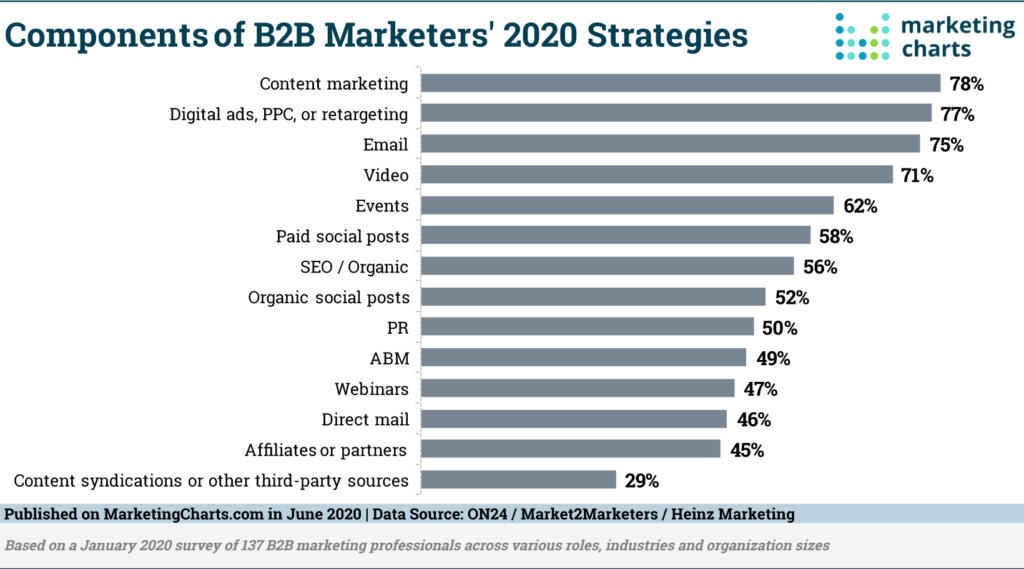What would “Winning with Google Adwords” look like to you?
It’s an important question, and it’s critical to determine if you’re going to be successful with Google Ads or just another contributor to the Google Empire.
But let’s not get ahead of ourselves.
A Quick Overview Of Google Ads
Notice I referred to them as search ads?
Many people are unaware there are currently five completely different types of google advertisements; Search Ads, Display Ads, Product Ads, Video Campaign Ads, and App campaign Ads.
We are focused on the ads your probably most familiar with, with the possible exception of all those annoying youtube ads.
Search Ads or Google Adwords show up at the top and bottom of Google anytime you perform a search for a word or phrase, and someone is willing to pay for the opportunity to show you an advertisement.
Digital Marketers frequently prioritize Adwords Campaigns as the cornerstone of a successful Marketing Strategy, and for good reason.
A quick look at Google for the current search term “flannel shirts” shows the google Adwords in blue at the top and bottom of the results page in these Google Ad examples.
Google’s Push Towards Paid Results, Now More Than Ever
Placement is not the only thing the graphic shows. The image to the right highlights the focus Google is giving to paid advertisers, and the de-emphasis on search engine optimization.
The Red and Blue sections are both paid advertisements. The Yellow is additional features, and the Green areas are the only natural search results, roughly only 33%.
The Google SERPs (Search Engine Results Pages) are becoming more and more overrun with paid advertising to the point that even being in the top 10 results will not guarantee you’re on the first page.
Breaking Into The World of Google Ads – Risks, And Rewards
The upside of PPC is clear, immediate exposure on the first page of Google.
Ads put your product or service directly in front of your specifically targeted potential customers.
The marketing world 50 years ago could have only dreamed of such a possibility.
The downside though, is the possibility of burning through marketing budgets at a rate that would make Las Vegas Casinos jealous.
A successful Google Adwords Campaign requires diligence and patience. It will take time to finely tune your specific business requirements to utilize the Google Marketing Machine optimally.
Many Google AdWords account customers have thrown good money after bad chasing the wrong metrics.
Even so, there is no doubt that online marketers recognize the power of Ad Campaigns and have made it a central part of their marketing strategies for 2020.

PPC The Right Way – A 10 Step Guide every PPC Campaign Should Start with.
1. Establish a precise Conversion – AKA. Is This Worth It?
In the 1880’s John Wanamaker famously said,
“Half the money I spend on advertising is a success, and the other half is wasted; the trouble is I don’t know which half is which.”
Google Ads can be a rapid victory to success, but success comes with investment and risk if you don’t take the time to understand the game.
For Adwords to be profitable and provide a positive ROI, you will need to know exactly what you want, what it is worth, and how much you are willing to spend to get it.
As with any Marketing Campaign, conversion tracking is going to be necessary to validate your investment.
You can find the value of a single conversion or lifetime value of a new customer, to determine the goals for your marketing strategy.
Let’s say Pat sells widgets for $100. The total cost to sell this widget, including purchase price, management, customer service, returns, and shipping, is averaged to $50.
If Pat’s average customer will make three purchases from Pat over time, then the average lifetime value of a new customer is $150 to Pat.
If Pat’s website has a 2% conversion rate (2% of customers that arrive will purchase), then the value of every new customer to Pat’s website is worth $3.
With this information, we can accurately target our two most important goals.
Pat will want to make sure that every click to his site has a max cost per click of no more than $3 and that his cost per conversion is not more than $150.
Every increment under those numbers is profitable advertising.
It’s important to understand that it is extremely rare to hit these goals immediately. It usually takes tweaking and fine-tuning, but after that, it’s all gravy!
If your business model is service instead of sales, your marketing strategy will be a little different, but you can still establish a goal that can be quantified.
If you are looking for leads, consider the first contact as your method of conversion tracking.
If you are an interior decorator who usually makes $500 per job and regularly can close 1 out of every 20 contacts, your max cost per conversion (contact) would be $25.
2. Focus on the Destination First, Not Transportation.
Imagine two different E-Commerce store owners. Pam and Jack both sell the same products.
Pam has a beautiful store, her products are displayed well with attractive pictures, clear descriptions, and her prices are reasonable, when people arrive, they usually purchase.
Pam has a conversion rate of 5%. Pam’s problem is that it isn’t easy to find her on the internet. Pam only gets about 100 visitors a day.
Jack’s store is not organized well, his pictures are not good, and his prices are higher than his competitors.
According to Google Analytics, Jack has done well with search engine optimization, he has a high click-through rate, but his conversion rate is only 1%.
Jack is getting about 1000 visitors a day, so by converting 1%, he is still doubling Pam’s sales.
If we were to do a PPC Audit, in this situation, Pam would be an ideal candidate for Google Ads. She already has a good product and a nice store that people are buying from.
Pam just needs to get more customers into her store, a PPC campaign, and possibly search engine optimization would be on the shortlist for her Marketing strategy.
Jack, on the other hand, would be better served to improve his website to increase conversions with customers he already has first.
There is no reason for him to pay for customers that are not likely to purchase.
The destination your sending customer to should be optimized for performance and conversions first.
Being the diligent Digital marketers that we are, we established what our goal conversion should be for our Adwords campaign in the first step.
When a customer clicks your ad, everything they see from that point on should be guiding them to that action.
3. Targeting: Focus on Questions Before Keywords.
The key to finding customers who want to buy your product is to think like your customers.
Most business owners have a hard time thinking like their customers.
Typically business owners are used to their own industry terminology and familiarity.
An example would be a car lot owner advertising for pre-owned vehicles when all their customers search for used cars.
It helps to research questions your likely customers are actually asking when they are searching for your product or service.
This is a step where it pays to utilize professional tools to find common questions customers are currently asking online.
Free tools such as Answer The Public, Google Trends, and Quora can provide some ideas.
Digital Marketers will use professional versions of tools such as SEMRush.com Moz.com or Ahrefs will provide better data to get the best results.
4. Curate your list of keywords and phrases
It used to be common practice to brainstorm for as many keyword ideas as possible to start your keyword list.
With the new tools we have now, we can quickly see that’s a bad idea.
With your list of common questions, you will have a good starting point to build your keyword list off of.
You will want to identify the questions, keywords, and phrases used by customers with the intent of purchasing, rather than just browsing.
You could use some free tools such as Google Keyword Planner. However, the best tools will require an investment.
Professional tools will tell you what keywords your competitors are using in their Ads Campaign, what’s working for them, and what they are neglecting.
We will create keywords and phrases in a few different “match types”; phrases, exact matches, and keyword modifiers.
- “This is a phrase” – A phrase is a string of words that must appear with or without other words, but in that exact order.
- [This is an exact match] – An exact match means that these words appear in this manner and are the only words in the search.
- +Broad +Match +Modifier – A Broad match modifier indicates that the search must contain each word with a + in front of it, but they can be in any order and with any other words around them.
- Broad Match – A Broad match is a search for any of the words listed in any order with any other terms. This type of search is not recommended any longer; we will explain why next.
5. Create Your Negative Keyword List
A negative keyword is a keyword match type that will prevent your ad from showing.
Common words you might use for these are; “used,” “complaints,” “hiring,” “competitors,” “photos,” etc.
Those are all words that indicate the searcher is not looking to purchase your product.
Previously, Google would allow you to see what people’s searches were when they found your ad.
It was a popular strategy to use Broad Match searches to identify negative keywords that you do not want to show up for.
Without the ability to see what customers typed in to see what caused your ad to display, your ability to find negative words is limited.
In 2020 Google decided to hide this information from advertisers.
Marketers can no longer see what a customer typed into the Google search box.
This decision has made it both more complicated and critical to research negative keywords carefully.
It’s essential to do thorough research into each of your phrases and limit your searches to exact and phrase matches as much as possible.
6. Structuring Your Account
A long term marketing strategy has to keep budget in mind for every The most important part of your ad structure will be to create multiple Campaigns.
The reason for multiple campaigns is that you can set different daily budgets for each ad campaign.
Separate budgets allow you to optimize for each category on your site.
You also can move the budget around from one Campaign to another if needed.
For each Campaign, you will have multiple Adgroups.
A singular related topic can usually identify Adgroups, and the ads within them will be going to the same page.
Within each Adgroup, you will have multiple versions of your ads, keywords, and negative keywords.
This type of structure allows you to create specific ads for specific pages without competing with yourself.
7. Creating successful ads, titles, and content.
Creating successful titles is a crucial part of getting the right people to stop, read, and click on your ad.
Many common strategies have proven to be successful than others.
Regardless of the strategy, titles will usually include the searched term, and the immediate value to the customer.
The keyword should also be featured on the page the ad links to.
You may need to break out your ads into separate ad groups and create a new landing page in some cases.
Finally, to take full advantage of AdWords, you will want to utilize the advanced ad features to make your ads stand out.
The advanced ad features include dynamic ads, responsive ads, extensions, site links, callouts, Call extensions, and structured snippets.
These advanced tools could easily make up their own entire post, but we encourage you to explore them.
8. Bidding Strategies
“How much do I need to spend on Adwords?”
It is a common question and a fair one to ask, but it’s not asking the right question, as we will see.
You can start with almost any dollar amount, but it’s unlikely to be effective.
There are two phases of bidding for Google Adwords;
Firstly, the introductory phase when you’re learning what works and what doesn’t.
Secondly, you have the adjustment period. The adjustment period is in other words, everything after the first phase.
Getting comfortable with what works and what doesn’t will typically involve you getting somewhere between 100 – 1000 conversions.
The sooner you achieve the conversions, the sooner you can start making adjustments.
If you decide you want only to spend $5 a day, it may take you a few months.
If you are spending $100’s to $1000’s per day, you should have some accurate data in a day to a week.
A typical starting suggestion is somewhere between $50-$100 / day.
That amount will usually give you some useful data in about a month.
Once you have made your adjustments and your advertising becomes profitable, the math is easy.
You keep spending more until you hit the point of diminishing returns, you’re making less money by doing so.
9. Monitor your data as often as possible
You will want to at least glance at your account every day or so. You want to spot issues before they get out of hand.
Logging into Adwords and reviewing the data there be get cumbersome and inefficient, in most cases, you won’t do it.
A better solution is to have a custom report delivered directly to your inbox daily, or at least weekly.
A custom report can be viewed at a glance, right in your email, even on your phone, like any other email.
Make sure your report contains the following metrics.
Total Conversions – By Device
Cost Per Conversion -By Device
Total Clicks – By Device
Cost Per Click – By Device
10. Please don’t Set It And Forget it.
Pay attention to your campaigns, ad groups, and keywords.
Be sure to adjust your ads based on your site content. Sell out of a product? Don’t advertise for it.
Take the least performing ads that are costing money and move that budget to more successful ads.
If you notice one particular group, ad, or keyword that performs better than everything else in a campaign, separate it into a new Campaign.
Final thoughts
Google Ads are a quick way to score big results if your business is solid but needs traffic.
To be profitable will require some serious time learning the tools and techniques of the trade, but it can be worth it.
If you need help, Rhino Group can provide an expert evaluation of your business, advise if PPC is right for you, and professionally manage your entire account if you prefer.
Contact us today!



